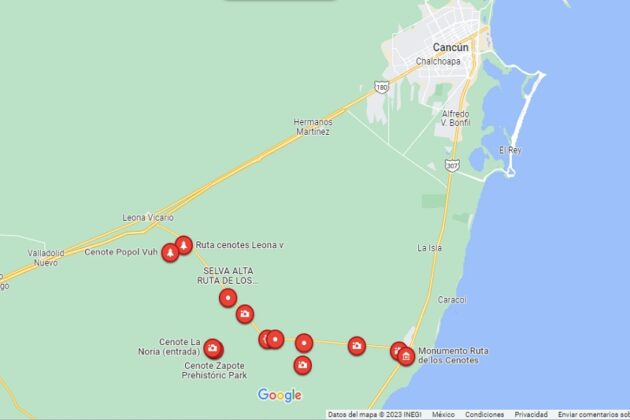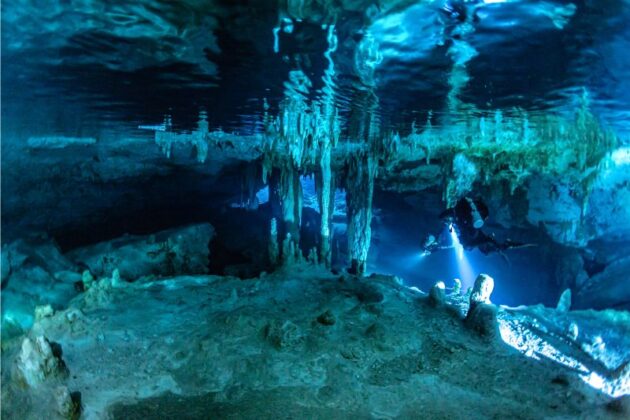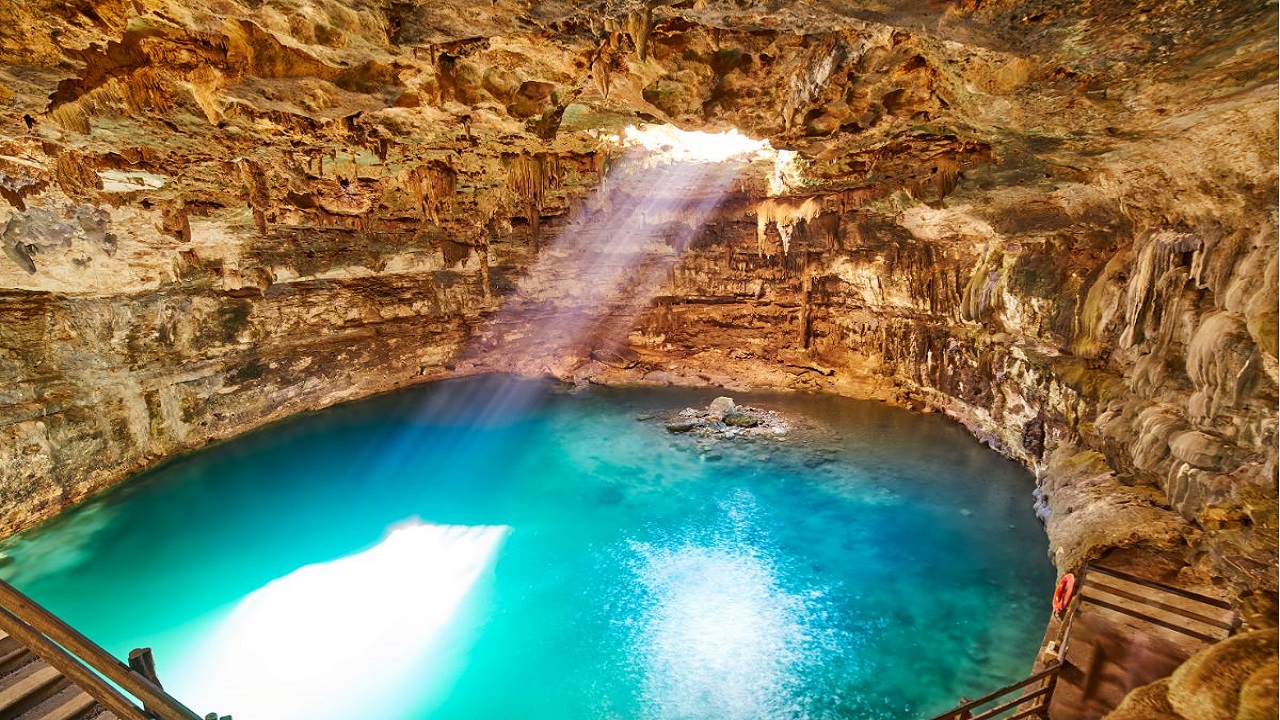The beautiful Cenotes are one of the many attractions you can enjoy on your trip to Cancun and the Riviera Maya …
There are many experiences offered by the Mexican Caribbean, the beaches of Cancun and its impressive sea are the main stars, but you also find incredible natural settings that promise to dazzle you.
Jungle, mangroves, and cenotes in Cancun are part of the beauties that nature has given to southern Mexico and that are really worth visiting; here we tell you why…

What is a cenote?
In simple words, a cenote is a freshwater well located in geological depressions supplied by an underground river.
However, the word cenote is much richer in meaning since it comes from the Mayan word “dzonot” which means “abyss” and they were considered by the Mayan culture as sources of life that provide the vital liquid.
In addition, the cenotes were recognized as an entrance to another world and a center of communion with the gods.
The Yucatan Peninsula, Mexico is the place where you find these incredible spring water deposits thanks to the fact that is in that area, where the geological composition of the soil allowed the formation of caves that collapsed and gave rise to the most beautiful cenotes in a process of formation that takes hundreds of thousands of years.

Useful information before visiting the Cenotes in Cancun
On your tour of the states of Campeche, Yucatán and Quintana Roo you will find open, semi-open, ancient and cavern cenotes, each one with a particular beauty that will leave you speechless.
But, when the time comes to go to a cenote in Cancun, it may help you to know some information such as:
Temperature in cenotes of Cancun
Like many people, you will surely wonder: How cold is the water in a cenote?
It’s good to keep in mind that it depends on how used you are to swim in different temperatures. For some visitors, the water in a cenote can feel a bit cold, although, in reality, the average temperature is 24 C degrees.
You must consider that as it is underground water and if it is a cavern-type cenote, the sun doesn’t help too much.
What do you wear to cenotes?
Based on the previous point and depending on how cold you are, you can wear a suitable swimsuit for this, most people wear the same suit they wear on the beach, but you could complement it with a water shirt or something additional if you think you’ll be cold or if you plan to swim for a long time.
Can I use sunscreen in a cenote?
An important detail is that you can’t use sunscreen, makeup and similar products in most of the cenotes in Cancun and other destinations, because it may affect the water.
For this reason, before entering, they will surely ask you to take a shower and take the opportunity to go to the bathroom.
It is ok to swim in cenotes?
A lot of people ask us if it’s safe to swim in cenotes in Cancun, the answer is that in most of them yes, you can swim but you must consider that some cenotes are very deep, so wearing a life jacket is recommended.
Even if you know how to swim, don’t trust yourself because is not like the sea, and find out why it is easier to swim in salt water (sea) than in freshwater (cenote)…
Are there cenotes in Cancun for children?
The reality is that access to cenotes is not restricted for kids, They can swim with you but you must consider the above points, is preferable that they swim with a life jacket (always accompanied by an adult) and you should monitor their temperature so they don’t get too cold.
If you want to do scuba diving in the cenotes of Cancun there is minimum age and certain experience required, search for an established dive shop for greater security if you want to do any of these activities.
Prices of cenotes in Cancun
Swimming or visiting a cenote is very cheap, most of them have quite affordable prices depending on the services they offer around, which are very useful for your comfort.
The smaller cenotes (or those with fewer services) are usually cheaper, it will depend a lot if you want a more comfortable visit or you are interested in swimming and discovering a more virgin place with fewer tourist services.
There are also free cenotes but they are usually small or not very visited, The disadvantage in these cases is that you must be more careful in case of any accident when going up or down because they usually don’t have adapted stairs or platforms to easily enter.
Finally, it is highly recommended to follow the guide for the responsible use of cenotes to preserve these treasures that nature gives us. This implies not damaging the natural environment, If there are stalactites or stalagmites don’t touch them, don’t cut vegetation, respect the animals in the area, etc.

Route of the Cenotes (Ruta de los Cenotes)
The number of cenotes in Mexico is enormous, According to various sources, there are around 10,000 cenotes in the Yucatan Peninsula, a number that is estimated to keep increasing.
Imagine all the incredible things you can visit, but for starters, the Ruta de los Cenotes, located less than an hour from Cancun and close to Puerto Morelos, is a good idea.
This proposal is ideal for those who love sustainable tourism since they will enjoy a unique experience knowing fascinating places.
In addition, they will have the possibility of practicing other activities such as camping, zip-lining, bungee jumping, mountain biking, rappelling, horseback riding, ATVs, bird watching, diving and snorkeling, etc.
The Cenote Route is 50 kilometers of jungle that has everything described above as well as the town of Central Vallarta and Leona Vicario.
How to get to the Cenotes Route?
Getting to the Cenotes’ Route from Cancun by car is very easy, you just have to take the road towards Puerto Morelos / Playa del Carmen and before reaching Puerto Morelos you must take the side road to avoid the bridge and go to the detour, there you will see a ceiba tree that marks the beginning.
If you want to go by public transportation from Cancun, you must go to the Cancun bus terminal (ADO), where a bus leaves every hour along the Ruta de los Cenotes, reaching Leona Vicario. You can get off wherever you want.
Also at the same ADO terminal, buses leave for Chiquilá and these pass through Leona Vicario (7:45 am and 1:45 pm). You must get off at Leona Vicario and take one of the buses that leave to Puerto Morelos, you can get off wherever you want and explore as you wish.
The adventure begins at the Monument to the Cenotes Route in Puerto Morelos, that is where the route begins, on the way to the town of Leona Vicario, which will take you to magical places.
Some of the cenotes that you can visit following this route are:
Las Mojarras Cenote
Open, it has a depth of 14 meters and 65 meters in diameter.
Siete Bocas Cenote
It has seven vents that allow you to see the different faces of the cenote, some connected to each other.
Cenote Boca del Puma
It is an underground cenote located in an ecological reserve.
Cenote Verde Lucero
It is an open cenote, with a depth ranging from 3 to 30 meters; It has platforms from which to launch yourself on zip lines.
Cenote La Noria
Located in the Káat-Ha Recreational Park, with a depth of 18 m; To get to it you will have to descend some 10 m stairs.
Zapote Cenote
Open, it is 36 meters in diameter and 52 m deep, surrounded by nature, you get there by zip line or by going downstairs. In the same park you will find two other cenotes, Abuelo Che Che and Las Palmas.
Kin Ha Cenote
An underground cave that has an opening through which light enters is 40 m deep.
Cenote Blanca Flor
Under the open sky, dare to jump into its waters from the zip lines or you can get on the platforms and jump from 14 m, it is for the brave.
Cenote Lu’um
It is a cavern-type formed by a vault of stalactites, impressive.
Cenote Popol Vuh
Open, it is surrounded by jungle and with many activities to enjoy the day.
The list does not end there, there are other cenotes on the same route, ask for recommendations from local people and discover much more.
It is worth clarifying that, due to the large number of these incredible formations, several destinations in the south of the country will likely talk about the cenote route, don’t miss the opportunity, go ahead and visit them!

Top 5 Cenotes near Cancun
If you are looking for cenotes in Cancun you will have a huge list and it is necessary to mention that they are not in the same city or the Hotel Zone, but rather nearby.
The ones we mentioned before, on the Cenote Route, are a very good proposal and are located very close, just 40 km from Cancun, where you have all kinds of cenotes and activities to enjoy.
But, if your idea is to discover much more, we are going to offer you other alternatives that you cannot miss.
1. Cenote Choj Ha
You find it 30 minutes from the city, at km 218 of the Cancún – Valladolid highway.
It is a cave with stalactites and stalagmites and it has a plus, there you can visit the indigenous archaeological zone of Naranjal.
2. Cenote Río Secreto
It is 1 hour and 15 minutes away from Cancun and 30 minutes from Playa del Carmen, ideal for adventurers who enjoy swimming in a cave and discovering the impressiveness of the underground world. You need a certain physical condition. You can also get married there.
3. Blue Cenote
Located 1 hour and a half from Cancun, it is ideal to enjoy with the family as it has shallow areas for the little ones in the house to have fun. Don’t forget your snorkeling equipment, the amount of fish is something you will love to observe.
4. Cenote Chac Mool
Located 22 km from Playa del Carmen, it is a cavern and has a halocline, that is, where salt and fresh water come together and create visual effects; perfect for dawn diving. There you find two other cenotes, the Little Brother cenote and the Kukulkan cenote.
5. Cenote Sac Actun
It is located 1 hour and 50 minutes away from Cancun, very close to Tulum, also known as “La Cueva Blanca”, it is the second largest underwater cave complex on the planet with 130 interconnected cenotes in it.
There you will be able to visit the famous Cenote Dos Ojos, with its natural beauty during the day, and a center for international electronic music events a few nights a year.


